
|   |

|   |
Warrior Women of Bharat - Manjari Sinha e-mail: manjari@sinha.com Photos: Innee Singh May 16, 2022 'Warrior Women of Bharat', a special dance theatre production paying tribute to the women warriors of India who fought against the British, was premiered on World Dance Day, the 29th of April, to thunderous applause and a standing ovation by the overflowing crowds at the India Habitat Centre, Delhi. Conceptualized by eminent Bharatanatyam dancer Prathibha Prahlad and produced jointly by the Indira Gandhi National Centre for Arts (IGNCA) and the Prasiddha Foundation, the multi-style theatrical production featured senior Indian classical and contemporary dancers and theatre actors from all over the country. Prathibha Prahlad, Shovana Narayan, Anita Ratnam, Sharodi Saikia, Alekhya Punjala, Gopika Varma and Meera Das performed in their respective styles while Rashmi Vaidyalingam and Averee Chaurey as Sutradhars (storytellers), knitted the valorous lives and indomitable spirits of the warrior women like Rani Velu Nachiyar of Tamil Nadu, Rani Chennamma of Karnataka, Rani Avanti Bai of Madhya Pradesh, Rani Lakshmi Bai of Jhansi, Begum Hazrat Mahal of Awadh, Kanakalata Barua of Assam and Capt. Lakshmi Sehgal of the Indian National Army. The multi-style dance theatre production celebrated the lives of these fearless, heroic women who, driven by patriotism and love for their motherland, took up arms and entered the battlefield to fight British imperialism. The freedom struggle is replete with tales of thousands of warriors, who fought the British until their very last breath, to preserve the territorial freedom and integrity of their motherland. Stripped of their titles, humiliated, and cheated, these royals, nobles and commoners did not meekly accept their freedoms being taken away and fought with all their might. Women warriors picked up the sword when men gave up or were killed to fight for the territorial, physical, and fiscal integrity of their lands. 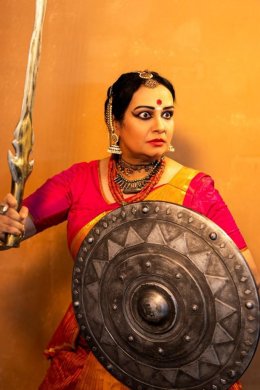 Prathibha Prahlad Prathibha Prahlad as Rani of Jhansi, Lakshmi Bai mesmerized the audience with her powerful performance. The way she fought even after being wounded and falling off her horse will be etched in the audience's memory. The Sutradhaar tells us "Usne maidan mein lad-marne ki khai hai qasam" (she has pledged to die fighting) and when Rani Lakshmi Bai quotes Lord Krishna to galvanize her army, "Hato va prapsyasi swargam, jitva va bhokshyase mahim / Tasmaduttishtha Kaunteya Yuddhaay krit nishchayah" - "If we are victorious we will enjoy the fruits of victory; if defeated and killed on the battle field, we shall surely earn eternal glory and salvation" were moments of goosebumps. Prathibha's imaginatively woven rhythmic jathis interspersed within her Bharatanatyam movements also added impact to her impressive performance. 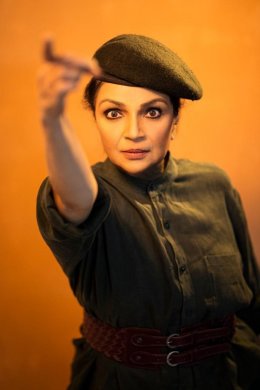 Anita Ratnam Anita Ratnam as Capt Lakshmi Sehgal was outstanding. Her slow and sustained movements on the alapana and tanum by a single male voice without even the drone support of a tanpura while she fed and looked after the poor migrants who came from India (to Singapore) in 1942 and then her valorous transformation as Capt. Lakshmi Sehgal filled everyone with pride. Her "Qadam qadam badhaaye ja" accompanied by just a flute and the military drum, had everyone humming along and thumping their feet to the famous marching song. 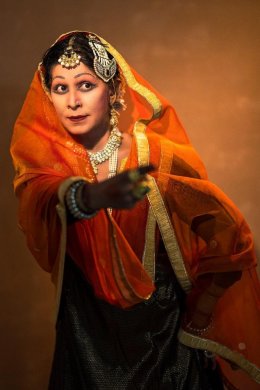 Shovana Narayan 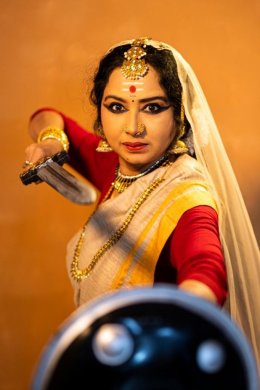 Gopika Varma 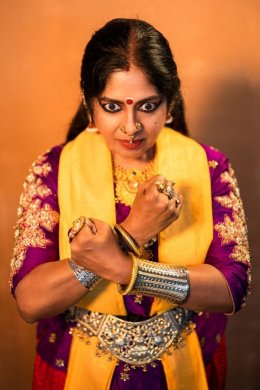 Alekhya Punjala 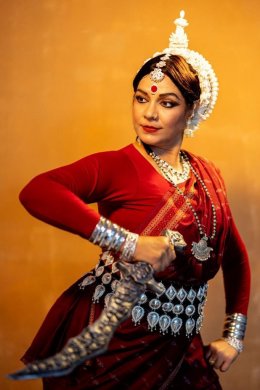 Meera Das Shovana Narayan as Begum Hazrat Mahal of Awadh gave an energetic performance. Alekhya Punjala as Rani Velu Nachiyar brought out the fighting spirit of Tamil women with ferocity. The patriotism of Kittoor Rani Chennamma by Gopika Varma and Rani Avanti Bai by Meera Das was inspiring. North East was represented by the acclaimed Sattriya dancer Sharodi Saikia who enacted the brave patriot Kanakalata Barua with the spirit of "karo ya maro" (do or die). Kanakalata was shot trying to hoist the Indian flag during the Quit India movement. 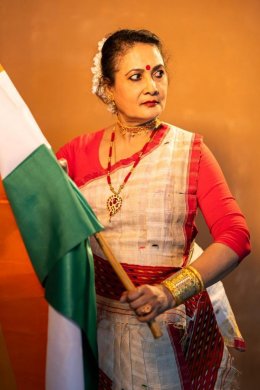 Sharodi Saikia The dramatic dialogue delivery of the Sutradhar Rashmi Vaidyalingam knitting the story of all these women fighters was effectively interspersed with impromptu Hindi, Urdu even Sanskrit verses. She also helped with the handling of props, like holding the national flag from the hands of the dying Kanakalata or taking away the fabric used as a cradle by Anita Ratnam when she transformed into Capt Lakshmi Sehgal in her military uniform. Most of the audience left teary-eyed with the overwhelming emotion of patriotism. Costume designer Sandhya Raman shared her experience. "I had to bring out not just the personality of the warrior women but also the dance form each of them performed while depicting those characters. For riding the horse, Lakshmi Bai needed a sari with split parting. Gopika as Rani Chennamma and Alekhya as Rani Velu Nachiyar were the royal princesses so the opulence in colours and shades mattered. Mooga silk was used for Sattriya dancer Sharodi Saikia enacting the indomitable Assamese patriot Kanakalata Barua. I had to visualize Capt. Lakshmi Sehgal before choosing her fabric and colour. As Dr. Lakshmi Swaminathan, she wore the sari-like pallu that she used as a cradle, but it was discarded during the military uniform of Captain Lakshmi Sehgal of the Indian National Army. If Begum Hazrat Mahal of Awadh wore the flared Gharaara Sharaara with the heavily embroidered dupatta for Kathak, the Odissi dancer Meera Das as Rani Avanti Bai wore the Odissi belt." What impressed me most was the superb music arrangement by K. Venkatesan, Ramamurthy Kesavan and Madho Prasad with a large number of musicians for so many different dance styles singing and playing their own melodic and percussion instruments tuned to pitch-perfect harmony. Music is the very lifeline of any successful dance production and here it was to match not just the dance but the dramatic 'dance-theatre' production. These extra dramatic effects could be seen, for instance, the 'Jhammm' of the jhaanjh (big cymbal) of Madho Prasad marked the 'sam', not just for Kathak but for the music of different dance forms, adding a dramatic effect to intensify the impact of that moment. This production paid homage to these outstanding, emancipated, courageous women, who did not shirk picking up arms and going to the battlefield to fight against the imperialism of the British Raj. Every patriotic Indian should remember the sacrifices made by our unsung women who died fighting for their motherland. There could be no better offering for the 'Azadi Ka Amrit Mahotsav' celebrating 75 years of India's independence, than this. 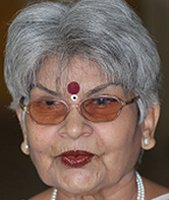 Manjari Sinha has an M.A. in Sanskrit and Music, and trained in vocal, tabla, sitar and Kathak dance. She has regular columns in national dailies as a music and dance critic. |